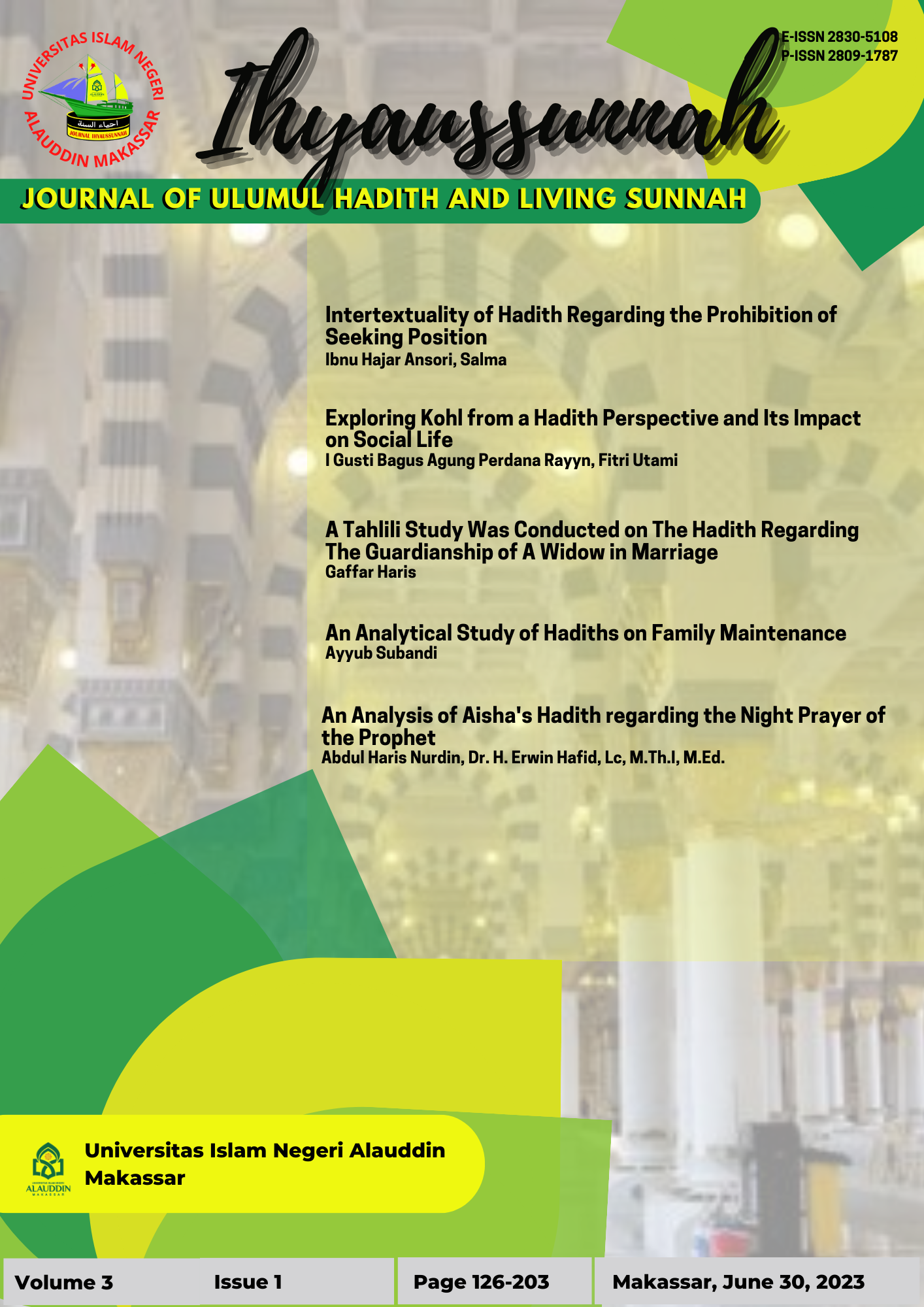Exploring Kohl from a Hadith Perspective and Its Impact on Social Life
Abstract
This article focuses on Prophet Muhammad's hadith-reports about kohl, specifically those made from iṡmid, which is a Sunnah of the Prophet Muhammad. The article examines two main topics: the interpretation of the hadith regarding the use of kohl made from iṡmid and its impact on applicative, health, and economic aspects. To gain a comprehensive interpretation and understand its implications, interpretive analysis (textual, intertextual, and contextual) is necessary. This research is literature-based and relies on literature related to the research object. The conclusion of this study is that the use of kohl made from iṡmid is highly recommended, even though ṡmid is not the only material used for making kohl. Wax made from iṡmid should be used regularly before bedtime or as a cosmetic to maintain eye health. On the other hand, ṡmid should be used as a raw material for making eyeliner. This can have a positive impact on increasing economic power in the beauty or fashion sector.
Downloads
References
Abu> al-H{usain, Ah}mad bin Fa>ris bin Zakariya>’ al-Qazwaini> al-Ra>zi>, ‘Mu‘jam Maqa>yi>s Al-Lugah’, in 5 (Da>r al-Fikr, 1917), p. 163
———, ‘Mu‘jam Maqa>yi>s Al-Lugah’, in 1 (Da>r al-Fikr, 1917), pp. 387–88
———, ‘Mujmal Al-Lugah Li Ibn Fa>ris’, in 1, II (Beirut: Muassasah al-Risa>lah, 1986), p. 162
Abu> Mans}u>r, Muh}ammad bin Ah}mad al-Azhari>, ‘Tahz}i>b Al-Lugah’, in 14, 1st edn (Da>r Ih}ya>’ al-Tura>s\ al-‘Arabi>, 2001), p. 65
al-Azdi>, Abu> Bakr Muh}ammad bin al-H{asan bin Dari>d, ‘Jamharah Al-Lugah’, in 1, 1st edn (Beirut: Da>r al-‘Ilm wa Mala>yi>n, 1987), p. 420
al-Badr, Syaikh ‘Abd al-Raza>q bin ‘Abd al-Muhsin, Syarh} Syama>’il Al-Nabi> Li Abi> ‘I
al-Bas}ri>, Abu> ‘Abd al-Rah}man al-Khali>l bin Ah}mad bin ‘Amr bin Tami>m al-Fara>hi>di>, ‘Kita>b Al-‘Ain’, in 8 (Da>r wa Maktabah al-Halla>l), p. 20
al-Fa>rabi>, Abu> Nas}r Isma>‘i>l bin H{amma>d al-Jauhari>, ‘Al-S{ah}a>h} Taj Al-Lugah Wa Al-S{ah}a>h} Al-‘Arabiyah’, in 2, 4th edn (Beirut: Da>r al-‘Ilm wa Mala>yi>n, 1987), p. 451
———, Muntakhab Min S{ah}a>h} Al-Jauhari>
al-Fad}l, ‘Iyya>d} bin Mu>sa> bin ‘Iyya>d bin ‘Amru>n al-Yah}s}abi> al-Sibti> Abu>, ‘Masya>riq Al-Anwa>r ‘ala S{ah}a>h} Al-A
al-Ifriqi>, Muh}ammad bin Mukrim bin ‘Ali> Abu> al-Fad}l Jama>l al-Di>n Ibn Manz}u>r al-Ans}a>ri>, ‘Lisa>n Al-‘Arab’, in 11, 3rd edn (Beirut: Da>r al-S{a>dr, 1414), p. 584
———, ‘Lisa>n Al-‘Arab’, in 3, 3rd edn (Da>r al-S{a>dr: Da>r al-S{a>dr, 1414), p. 105
al-Jauziyah, Muh}ammad bin Abi> Bakr bin Ayyu>b bin Sa‘ad Syams al-Di>n Ibn Qayyim, ‘Za‘Dul Ma’Ad Bekal Perjalanan Akhirat’, in 5, ed. by Amiruddin Djalil, 5th edn (Jakarta: Griya Ilmu, 2015), p. 350
———, ‘Za>d Al-Ma‘a>d Fi> Hadi> Khair ‘Iba>d’, in 4, 17th edn (Beirut - Kuwait: Muassasah al-Risa>lah - Maktabah al-Mana>r al-Isla>miyyah, 1994), pp. 258–59
al-Naisa>bu>ri>, Muslim bin al-H{ajja>j Abu> al-H{usain al-Qusyairi>, ‘Al-Musnad Al-S{ah}i>h} Al-Mukhtas}ar Binaql Al-‘Adl ‘An Al-‘Adl Ila> Rasu>lilla>h S{alla>llah ‘Alah Wa Sallam’, in 2 (Beirut: Da>r Ih}ya>’ al-Tura>s\ al-‘Arabi>), p. 863
al-S{uqli>, Ali> bin Ja‘far bin ‘Ali> al-Sa‘di> Abu> al-Qa>sim Ibn al-Qat}t}a>’, ‘Kita>b Al-‘Af‘A>l’, in 3, 1st edn, 1883, p. 90
al-Syaiba>ni>, Abu> ‘Abdilla>h Ah}mad bin Muh}ammad bin H{anbal bin Halla>l bin Asad, ‘Musnad Al-Ima>m Ah}mad Bin H{anbal’, in 1, 1st edn (Muassasah al-Risa>lah, 2001), p. 231
al-Yumni>, Nasywa>n bin Sa‘i>d al-H{umairi>, ‘Syams Al-“Ulu>m Wa Dawa>” Kala>m Al-‘Ara>b Min Al-Kulu>m’, in 9 (Beritut - Damaskus: Da>r al-Fikr al-Ma‘a>s}ir - Da>r al-Fikr, 1999), p. 5778
Assegaf, Habiba M, Christina Avanti, and Ridho Islmaie, ‘EFEKTIVITAS PENGAWET PADA PRODUK LOKAL EYELINER WATERPROOFTERHADAP PERTUMBUHAN Pseudomonas Aeruginosadan Candida Albicans YANG DIJUAL DI PASAR BLAURAN KOTA SURABAYA’, Calyptra: Jurnal Ilmiah Mahasiswa Universitas Surabaya, 7.2, 1686–99
Darmalaksana, Wahyudin, and Busro Busro, ‘Kosmetik Halal Sebagai Lifestyle Untuk Kesehatan: Studi Takhrij Dan Syarah Hadis’, Al-Tadabbur: Jurnal Ilmu Al-Qur’an Dan Tafsir, 5.2 (2021), 218–30
Fadila, Aziyaty, ‘Bersolek Bagi Wanita Karir Pada Waktu Ihdad Dalam Perspektif Maqashid Syariah’, Skripsi (Institut Agama Islam (IAIN) Bengkulu, 2021)
Ibn al-As\i>r, Mujid al-Di>n Abu> al-Sa‘a>da>t al-Muba>rak bin Muh}ammad bin Muh}ammad bin Muh}ammad Ibn ‘Abd al-Kari>m al-Syaiba>ni> al-Jazari>, ‘Al-Niha>yah Fi> Gari>b Al-H{adi>s\ Wa Al-As\ar’, in 4 (Beirut: al-Maktabah al-‘Ilmiyah, 1979), p. 154
———, ‘Al-Niha>yah Fi> Gari>b Al-H{adi>s\ Wa Al-As\ar’, in 1 (Beirut: al-Maktabah al-‘Ilmiyah, 1979), p. 221
Jad, Syaikh Ahmad, Fikih Sunnah Wanita Panduan Lengkap Menjadi Wanita Muslimah, 1st edn (Jakarta: Pustaka Al-Kautsar, 2008)
Mulyani, Welia, and Febriyeni Febriyeni, ‘Eyeshadow as a Fashion Cosmetic in Review of Hadith’, Takwil: Journal of Quran and Hadith Studies, 1.2 (2022), 35–49
Nurhofipah, Syfa, ‘Itsmid Sebagai Eyeliner Dalam Kosmetika Dunia Muslim: Studi Takhrij Dan Syarah Hadis’, Jurnal Riset Agama, 1.2 (2021), 439–48
Wangsa, Fadhlina Arief, Studi Kritik Sanad Hadis Tentang Konsep ’Ishmah (Komparatif Shi’ah Imamiyah Dan Shi’ah Zaidiyah), 1st edn (CV Sejahtera Kita, 2019)
Copyright (c) 2023 I Gusti Bagus Agung Perdana Rayyn, Fitri Utami

This work is licensed under a Creative Commons Attribution-ShareAlike 4.0 International License.
Copyright
Authors who publish with IHYAUSSUNNAH JOURNAL OF ULUMUL HADITH AND LIVING SUNAH agree to the following terms:
- Authors retain copyright and grant the journal right of first publication with the work simultaneously licensed under a Creative Commons Attribution License (CC BY-SA 4.0) that allows others to share the work with an acknowledgment of the work's authorship and initial publication in this journal.
- Authors are able to enter into separate, additional contractual arrangements for the non-exclusive distribution of the journal's published version of the work (e.g., post it to an institutional repository or publish it in a book), with an acknowledgment of its initial publication in this journal.
- Authors are permitted and encouraged to post their work online (e.g., in institutional repositories or on their website) prior to and during the submission process, as it can lead to productive exchanges, as well as earlier and greater citation of published work.


